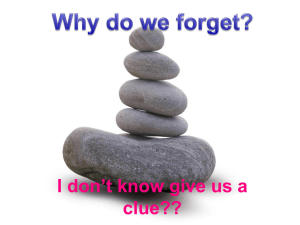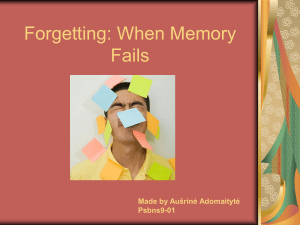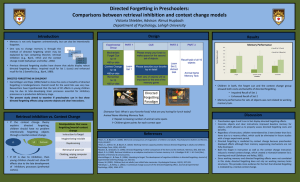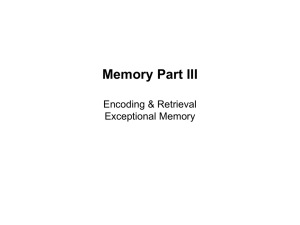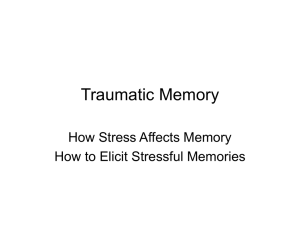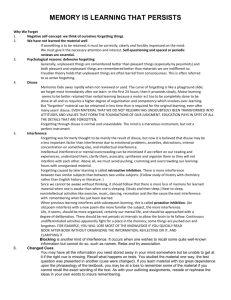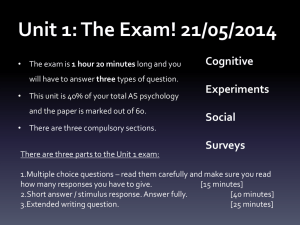240909 Mind Brain
advertisement
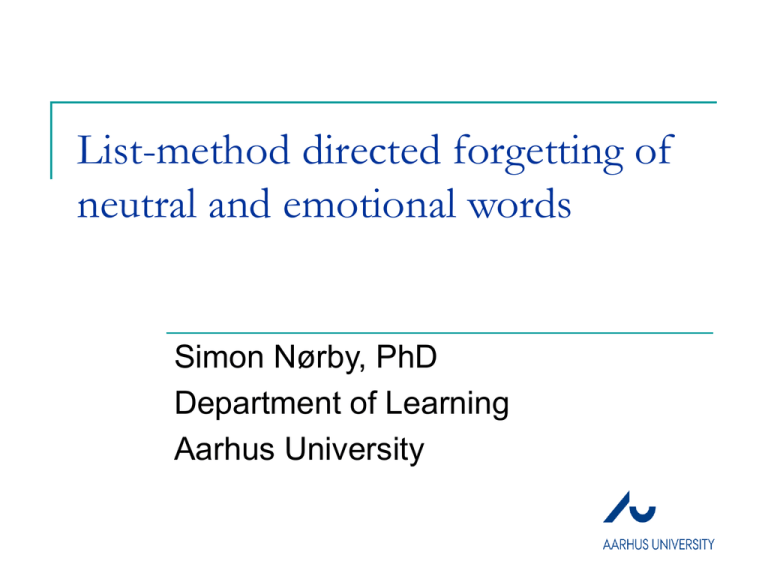
List-method directed forgetting of neutral and emotional words Simon Nørby, PhD Department of Learning Aarhus University The directed forgetting paradigm: Description Subjects are lead to believe that they should forget about a previously shown list of items. (see MacLeod, 1998) Four phases (always two lists) Presentation of list 1 An unexpected instruction to forget list 1 items Presentation of list 2 Free recall and maybe other memory tests Inferior recall of List 1 compared to list 2 items (or in relation to a control group). (see Bjork et al., 2006; MacLeod, 1998) The directed forgetting paradigm: Explanation Inhibition: What? Attempting inhibition of a bad memory Some mechanism lowers the state of activation of a memory. (see Bjork, 1989) Inhibition: How? Active forgetting in contrast to other theories (e.g. decay; interference). (see Anderson, 2005) Inhibition: Why? Forgetting in tests of recall but not recognition. (e.g. Basden, Basden & Gargano, 1993) From MacLeod, 2003 Design Aims To investigate forgetting of emotional and neutral stimuli. To test the “long-term” effect of volitional forgetting. Background Most studies on violational forgetting use neutral stimuli, but there are reasons that forgetting of emotional material may be especially difficult. People often want to retain positive and forget negative memories. The question about whether or not this is possible has clinical relevance. Most studies on violational forgetting apply immidiate tests. Important to investigate whether violational forgetting has prolonged effects. Design Subjects Danish students and recent graduates between 18 and 35 years of age. Materials 48 Danish nouns (controlled for word-length, frequency, semantics, concreteness, emotionality). 16 negative, 16 positive and 16 neutral nouns. Distributed evenly among conditions. E.g.: “tumor”, “gift”, “handle”. Procedure A standard list-method DF paradigm. The “whoops method”. A re-test after one week (+/- 4 timer). Results (1st session) Recall of neutral list 1 words inferior to recall of neutral list 2 words. Recall 50 Recall % 40 30 List 1 Recall of negative list 1 words slightly superior to recall of negative list 2 words. List 2 20 10 Recall of positive list 1 words inferior to recall of positive list 2 words. 0 Neutral Negative Positive Results (2nd session) Recall Increased difference in recall of list 1 and list 2 neutral words. 50 Recall % 40 30 List 1 List 2 Increased difference in recall of list 1 and list 2 negative words. 20 10 0 Neutral Negative Positive Still a minor difference in recall of list 1 and list 2 positive words. Interpretation It is hard to forget negative memories, and attempts to do so may increase recall of such memories, especially over time. Bad is strong (and stronger than good). Ironic processing of negative material (see Baumeister et al., 2001; Wenzlaff & Wegner, 2000) The result is consistent with the outcome of a study that employed the Think/no-think paradigm. Indicate that it is hard to forget the most unwanted memories, i.e., unpleasant memories. 30 Baseline corrected recall (%) NoThink: Emotional NoThink: Neutral Think: Emotional Think: Neutral 20 10 0 -10 0 (Baseline) 8 16 Repetitions (from Nørby, Lange & Larsen, 2010) Interpretation The increased forgetting effect on the neutral items over time could be due to: Inhibition not taking immediate effect. Emotional list 1 items having processing priority A remember-remember control group should be engaged. A new experiment should investigate the temporal aspect further. That was it… Thanks to: Axel Larsen Christian Gerlach Learning Lab Denmark (DPU) Center for Visual Cognition (KU)
